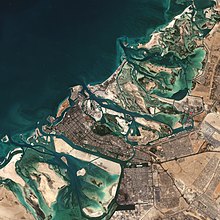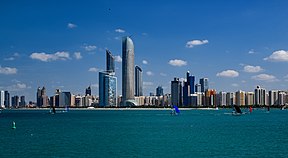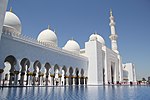
A | B | C | D | E | F | G | H | CH | I | J | K | L | M | N | O | P | Q | R | S | T | U | V | W | X | Y | Z | 0 | 1 | 2 | 3 | 4 | 5 | 6 | 7 | 8 | 9
Abu Dhabi
ʾAbū Ẓabī (أَبُو ظَبِي) | |
|---|---|
From top, left to right: Abu Dhabi's skyline, Emirates Palace, Al Ras Al Akhdar, Sheikh Zayed Grand Mosque, Ferrari World | |
| Coordinates: 24°28′N 54°22′E / 24.467°N 54.367°E | |
| Country | |
| Emirate | |
| Municipal region | Central Capital District[1] |
| Government | |
| • Type | Municipality |
| • Body | Abu Dhabi City Municipality |
| • Director-General of City Municipality | Saif Badr al-Qubaisi |
| Area | |
| • Total | 972 km2 (375 sq mi) |
| Elevation | 27 m (89 ft) |
| Population (2023)[3] | |
| • Total | 3,789,860[2] |
| Demonyms | Abu Dhabian, Dhabyani |
| GDP | |
| • Total | US$ 118.4 billion (2023) |
| • Per capita | US$ 75,600 (2023) |
| Time zone | UTC+4 (UAE Standard Time) |
| Website | tamm.abudhabi |
Abu Dhabi (UK: /ˌæbuːˈdæbi/, US: /ˌɑːbuːˈdɑːbi/; Arabic: أَبُو ظَبِي ʾAbū Ẓabī Arabic pronunciation: [ɐˈbuˈðˤɑbi])[5] is the capital city of the United Arab Emirates (UAE). The city is the seat of the Abu Dhabi Central Capital District, the capital city of the Emirate of Abu Dhabi, and the UAE's second-most populous city after Dubai.
Abu Dhabi is located on an island in the Persian Gulf, off the Central West Coast. Most of the city and the Emirate reside on the mainland connected to the rest of the country. As of 2023[update], Abu Dhabi's urban area had an estimated population of 2.5 million,[6] out of 3.8 million in the emirate of Abu Dhabi.[7] The Abu Dhabi Investment Authority is headquartered in the city, and was the world's 3rd largest sovereign wealth fund in 2022.[8] Abu Dhabi itself has over a trillion US dollars worth of assets under management in a combination of various sovereign wealth funds headquartered there.[9]
Abu Dhabi houses local and federal government offices and is the home of the United Arab Emirates Government and the Supreme Council for Financial and Economic Affairs. The city is home to the UAE's President, a member of the Al Nahyan family. Abu Dhabi's rapid development and urbanisation, coupled with the massive oil and gas reserves and production and relatively high average income, have transformed it into a large, developed metropolis. It is the country's centre of politics and industry, and a major culture and commerce center. Abu Dhabi accounts for about two-thirds of the roughly $503 billion UAE economy.[10]
History

The area surrounding Abu Dhabi is full of archaeological evidence from historical civilisations, such as the Umm Al Nar Culture, which dates back to the third millennium BC. Other settlements were also found farther outside the modern city of Abu Dhabi, including the eastern[11] and western regions of the Emirate.[12]
Etymology
"Abu" is Arabic for father, and "Dhabi" is the Arabic word for gazelle. Abu Dhabi means "Father of Gazelle." It is thought that this name came about because of the abundance of gazelles in the area and a folk tale involving Shakhbut bin Dhiyab al Nahyan.[5][13]
Origins of Al Nahyan
The Bani Yas was originally centered on the Liwa Oasis in the Emirate's western region. This tribe was the most significant in the area, having over 20 subsections. In 1793, the ruling Al Bu Falah subsection migrated to the island of Abu Dhabi on the coast of the Persian Gulf due to the discovery of fresh water there. The genealogically senior family within this section was the Nahyan family, which is now the ruling family of Abu Dhabi.[14]
Pearl trade
The pearl diving business was a key industry prior to the discovery of oil reserves. According to a source about pearling, the Persian Gulf was the best location for pearls.[15] Pearl divers dive for one to three minutes and would have dived as many as thirty times per day. Air tanks and any other sort of mechanical device was forbidden. The divers had a leather nose clip and leather coverings on their fingers and big toes to protect them while they searched for oysters.[16] The divers were not paid for a day's work but received a portion of the season's earnings.[17]
Trucial coast
In the 19th century, as a result of treaties (known as "truces" which gave the coast its name) entered into between Great Britain and the sheikhs of the Arab States of the Persian Gulf, Britain became the predominant influence in the area.[18] The main purpose of British interest was to protect the trade route to India from pirates, hence, the earlier name for the area, the "Pirate Coast". After the suppression of piracy, other considerations came into play, such as a strategic need of the British to exclude other powers from the region. Following their withdrawal from India in 1947, the British maintained their influence in Abu Dhabi as interest in the oil potential of the Persian Gulf grew.[19]
First oil discoveries
In the mid to late 1930s, as the pearl trade declined, interest grew in the oil possibilities of the region. On 5 January 1936, Petroleum Development Trucial Coast Ltd (PDTC), an associate company of the Iraq Petroleum Company, entered into a concession agreement with the ruler, Sheikh Shakhbut bin Sultan Al Nahyan, to explore for oil. This was followed by a seventy-five-year concession signed in January 1939. However, owing to the desert terrain, inland exploration was fraught with difficulties. In 1953, D'Arcy Exploration Company, the exploration arm of BP, obtained an offshore concession which was then transferred to a company created to operate the concession: Abu Dhabi Marine Areas (ADMA) was a joint venture between BP and Compagnie Française des Pétroles (later Total). In 1958, using a marine drilling platform, the ADMA Enterprise, oil was struck in the Umm Shaif field at a depth of about 2,669 metres (8,755 ft). This was followed in 1959 by PDTC's onshore discovery well at Murban No.3.[20]
ADMA discovered the Bu Hasa oil field in 1962 and the Lower Zakum oil field in 1963. Today, in addition to the oil fields mentioned, the main producing fields onshore are Asab, Sahil and Shah, and offshore are al-Bunduq, and Abu al-Bukhoosh.[20]
Geography

The city of Abu Dhabi is on the southeastern side of the Arabian Peninsula, adjoining the Persian Gulf. It is on an island less than 250 metres (820 ft) from the mainland and is joined to the mainland by the Maqta and Mussafah Bridges. A third, Sheikh Zayed Bridge, designed by Zaha Hadid, opened in late 2010. Abu Dhabi Island is also connected to Saadiyat Island by a five-lane motorway bridge. Al-Mafraq bridge connects the city to Reem Island and was completed in early 2011. This is a multi-layer interchange bridge and it has 27 lanes which allow roughly 25,000 automobiles to move per hour. There are three major bridges in the project, the largest has eight lanes, four leaving Abu Dhabi city and four coming in.[21]
Most of Abu Dhabi city is located on the island itself, but it has many suburban districts on the mainland, for example, Khalifa City A, B, and C; Khalifa City Al Raha Beach;[22] Al Bahia City A, B, and C; Al Shahama; Al Rahba; Between Two Bridges; Baniyas; Shamkha; Al Wathba and Mussafah Residential.
Gulf waters of Abu Dhabi holds the world's largest population of Indo-Pacific humpbacked dolphins.[23][24][25] To the east of the island is the Mangrove National Park, located on Al Qurm Corniche. Al-Qurm (ٱلْقُرْم) is Arabic for "The Mangrove".[26]
Climate
Abu Dhabi has a hot desert climate (Köppen climate classification BWh). Sunny blue skies can be expected throughout the year. The months of June through September are generally extremely hot and humid with maximum temperatures averaging above 40 °C (104 °F), mainly occurring during the peak summer months of July and August. During this time, sandstorms occur intermittently, in some cases reducing visibility to a few meters.[27]

The cooler season is from November to March, which ranges between moderately hot to mild. This period also sees dense fog on some days and a few days of rain. On average, January is the coolest month of the year, while August is the hottest. Since the Tropic of Cancer passes through the emirate, the southern part falls within the Tropics. However, despite the coolest month having an 18.8 °C (65.8 °F) average, its climate is far too dry to be classed as tropical.
| Climate data for Abu Dhabi (International Airport) 1991-present | |||||||||||||
|---|---|---|---|---|---|---|---|---|---|---|---|---|---|
| Month | Jan | Feb | Mar | Apr | May | Jun | Jul | Aug | Sep | Oct | Nov | Dec | Year |
| Record high °C (°F) | 34.3 (93.7) |
38.1 (100.6) |
43.0 (109.4) |
44.7 (112.5) |
46.5 (115.7) |
50.0 (122.0) |
49.3 (120.7) |
49.2 (120.6) |
47.7 (117.9) |
43.1 (109.6) |
37.9 (100.2) |
33.8 (92.8) |
50.0 (122.0) |
| Mean daily maximum °C (°F) | 24.5 (76.1) |
26.5 (79.7) |
29.7 (85.5) |
35.0 (95.0) |
39.6 (103.3) |
41.4 (106.5) |
42.5 (108.5) |
43.4 (110.1) |
40.9 (105.6) |
36.6 (97.9) |
31.0 (87.8) |
26.5 (79.7) |
34.8 (94.6) |
| Daily mean °C (°F) | 19.1 (66.4) |
20.6 (69.1) |
23.4 (74.1) |
27.7 (81.9) |
31.8 (89.2) |
33.7 (92.7) |
35.5 (95.9) |
35.9 (96.6) |
33.3 (91.9) |
29.7 (85.5) |
25.2 (77.4) |
21.1 (70.0) |
28.1 (82.6) |
| Mean daily minimum °C (°F) | 13.8 (56.8) |
15.9 (60.6) |
17.5 (63.5) |
21.1 (70.0) |
24.6 (76.3) |
27.0 (80.6) |
29.7 (85.5) |
30.2 (86.4) |
27.4 (81.3) |
23.7 (74.7) |
19.6 (67.3) |
15.7 (60.3) |
22.2 (71.9) |
| Record low °C (°F) | 5.6 (42.1) |
5.4 (41.7) |
8.4 (47.1) |
11.3 (52.3) |
16.6 (61.9) |
19.8 (67.6) |
22.2 (72.0) |
24.9 (76.8) |
20.4 (68.7) |
15.0 (59.0) |
13.1 (55.6) |
7.3 (45.1) |
5.4 (41.7) |
| Average precipitation mm (inches) | 12.5 (0.49) |
8.1 (0.32) |
12.9 (0.51) |
5.2 (0.20) |
0.3 (0.01) Zdroj:https://en.wikipedia.org?pojem=Abu_Dhabi,_United_Arab_Emirates Text je dostupný za podmienok Creative Commons Attribution/Share-Alike License 3.0 Unported; prípadne za ďalších podmienok. Podrobnejšie informácie nájdete na stránke Podmienky použitia.
Analytika
Antropológia Aplikované vedy Bibliometria Dejiny vedy Encyklopédie Filozofia vedy Forenzné vedy Humanitné vedy Knižničná veda Kryogenika Kryptológia Kulturológia Literárna veda Medzidisciplinárne oblasti Metódy kvantitatívnej analýzy Metavedy Metodika Text je dostupný za podmienok Creative
Commons Attribution/Share-Alike License 3.0 Unported; prípadne za ďalších
podmienok. www.astronomia.sk | www.biologia.sk | www.botanika.sk | www.dejiny.sk | www.economy.sk | www.elektrotechnika.sk | www.estetika.sk | www.farmakologia.sk | www.filozofia.sk | Fyzika | www.futurologia.sk | www.genetika.sk | www.chemia.sk | www.lingvistika.sk | www.politologia.sk | www.psychologia.sk | www.sexuologia.sk | www.sociologia.sk | www.veda.sk I www.zoologia.sk | ||||||||










